Maria Júlia tem 7 anos e passou para o 2º ano do ensino fundamental. Na escola, a menina ama brincar, fazer as tarefas e desenhar. Os desenhos preferidos são os de cavalos e patos. De pele clara, cabelos e olhos castanhos, ela faz questão de dizer que não tem medo do escuro, de cobra e nem de aranha-caranguejeira, seres mais-que-humanos que visitavam com frequência a sua escola. Mas há algo que faz Maria Júlia congelar: os “homens maus”. “Tenho medo deles porque é capaz de tocarem fogo nas crianças”, explica ela, com a voz abafada e protegida pelo colo e o abraço forte da mãe. Maria Júlia conhece os homens maus.
O medo de ser queimada viva não vem de nenhuma história de ficção. É da vida no Projeto de Assentamento Irmã Dorothy Stang, em Anapu, na Amazônia paraense. No dia 10 de janeiro, a Escola Municipal de Ensino Fundamental Paulo Anacleto foi incendiada tarde da noite. Como as casas ficam distantes da escola, não houve testemunha. Ninguém é capaz de identificar quem entrou na comunidade, sorrateiramente, e ateou o fogo. Do lugar onde Maria Júlia guarda lembranças de brincadeiras com os amigos, não sobrou quase nada. A escola, de 6 metros quadrados, foi feita de palha e talo de coco, num mutirão da comunidade, o que facilitou a propagação das chamas.
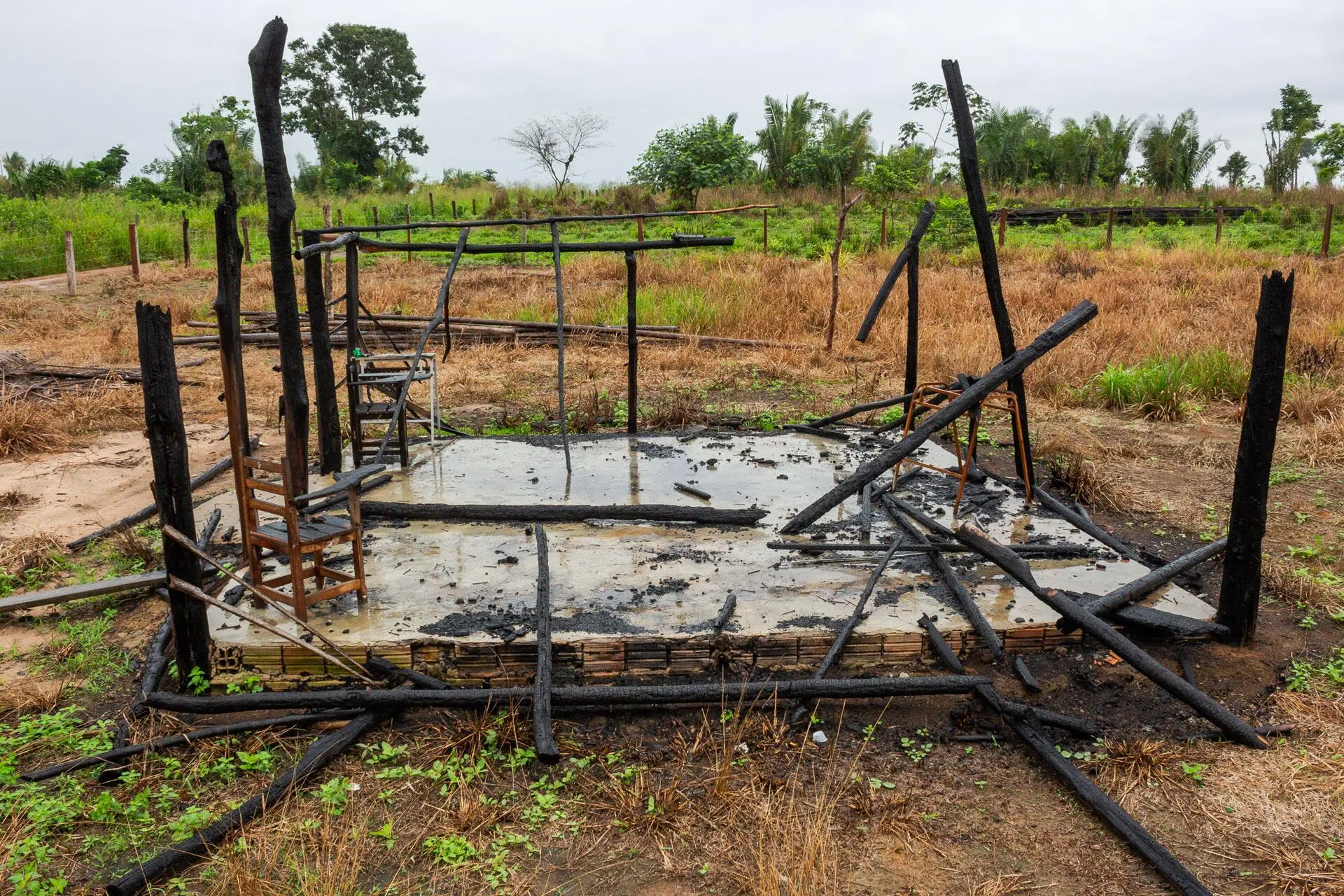
Ataque em dois atos: a Escola Municipal Paulo Anacleto foi queimada em 2022 e em 2024, num gesto de violência para impedir a fixação na terra
Os desenhos das crianças, que ficavam pendurados na parede de palha, viraram cinzas. No local, restaram apenas duas carteiras de madeira e duas de ferro. Um barracão, criado no mesmo espaço da escola para brincadeiras de pega-pega e esconde-esconde, desapareceu por completo. Apenas um banheiro de madeira, construído nos fundos, foi poupado da brutalidade. Um mês após o crime ainda era possível sentir o cheiro de queimado.
“Quem tem coragem de fazer isso com crianças?”, questiona Vanessa Vitoriano, de 32 anos, mãe de Maria Júlia. Ela sabe que o uso da violência é tática constante para aterrorizar as crianças e os moradores do Lote 96, onde está localizado o assentamento que leva o nome da missionária assassinada em 12 de fevereiro de 2005 no mesmo município. É a segunda vez que queimam a escola.
A vida no Projeto de Assentamento Dorothy Stang é uma batalha diária, mas o ataque à infância é uma estratégia recente. A escola é um dos principais espaços públicos para fixar uma comunidade no lugar e fortalecer os laços entre as famílias. Destruir a escola de forma recorrente é uma tática de expulsão. Mais uma. Foi também uma ameaça a seus filhos que levou a antiga liderança do Lote 96, Erasmo Theofilo, há três anos e meio no Programa de Proteção aos Defensores de Direitos Humanos, Comunicadores e Ambientalistas (PPDDH), a deixar o território. “Não precisa mais se preocupar em morrer, porque não vamos te matar. Vamos só arrancar o teu coração” – foram as frases ditas num dos áudios com ameaças que Erasmo recebeu por WhatsApp. Segundo pessoas da região, “atingir o coração” é atingir os filhos.
O primeiro incêndio criminoso, que também destruiu a Escola Paulo Anacleto, ocorreu em 18 de julho de 2022. “Na primeira vez foi diferente, eles atearam fogo e deram tiros para o ar, para intimidar mesmo. Dessa vez ninguém viu, só encontramos a escola queimada”, lembra Vanessa. Ela conta que, em 2022, os moradores se reuniram e fizeram outra escola de palha e talo de coco em pouco mais de dez dias.
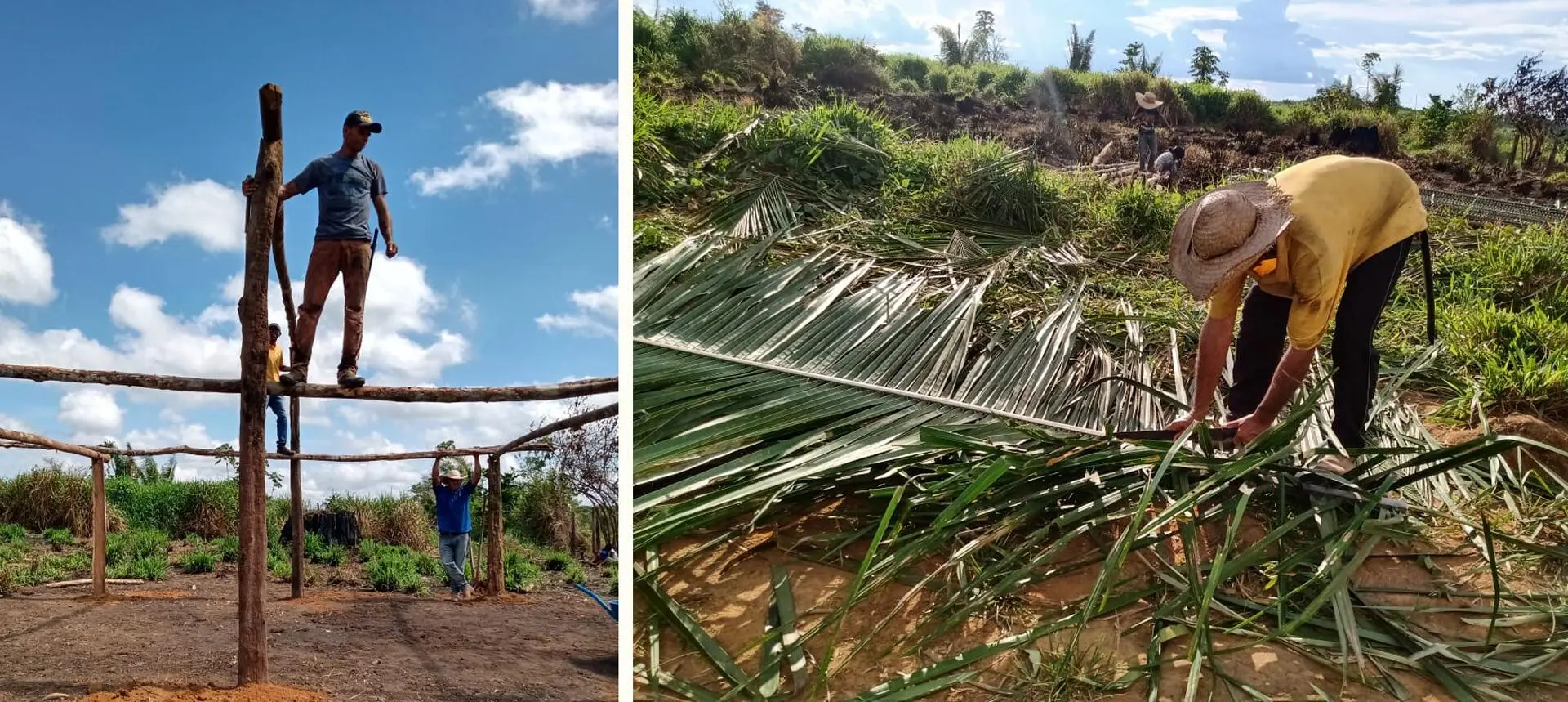
Resistência: há dois anos, quando a escola virou cinzas pela primeira vez, em dez dias a comunidade a reconstruiu com talos de coco e palha. Fotos: Erasmo Theofilo e Natalha Theofilo
Agora, após a reincidência da tragédia, a comunidade conseguiu a doação de 10 mil tijolos para reerguer outra escola, desta vez de alvenaria. Mas não bastará a força de vontade. Em reunião com a Promotoria de Justiça Agrária de Altamira, no dia 23 de janeiro, representantes do Ministério Público do Estado do Pará, em Anapu, relataram a decisão da prefeitura de não construir nem reformar a Escola Paulo Anacleto, alegando falta de recursos financeiros e número insuficiente de alunos matriculados – o mínimo deveria ser 25, e há somente 13. Os moradores fizeram um abaixo-assinado contra a decisão da prefeitura. No documento, afirmam que a Secretaria de Educação quer deslocar os alunos para a Escola Brasil Grande, que fica distante da comunidade – 15 quilômetros, segundo o Ministério Público. Até agora não tiveram nenhuma resposta do poder público.
“Como vamos mandar essas crianças tão pequenas em um carro com capacidade para dez pessoas, mas que leva 20, 25? Aceitar isso é mandar nossos filhos para morrer”, afirma Vanessa Vitoriano. Pai de Maria Júlia e de João Vitor, de 13 anos, o lavrador Agnaldo Costa Lima acrescenta que o veículo não é adequado: “Você já viu um pau de arara? Pois é, é um pau de arara que leva as crianças para a escola”.
Em mais um capítulo da resistência, os moradores levantaram uma escola improvisada de madeira em abril. A prefeitura disse informalmente, à comunidade, que a escola poderá voltar a funcionar em agosto. Mas, por enquanto, são apenas promessas. A prefeitura de Anapu não respondeu a questionamentos de SUMAÚMA sobre a situação da escola da comunidade.
Agnaldo chegou ao Lote 96 há 13 anos. Parou de estudar na antiga 8ª série do ensino fundamental [hoje é o 9º ano do Fundamental 2], após perder a mãe, aos 15 anos, e precisar trabalhar. “Não quero a vida que eu tive pra meus filhos. Como eu posso dar estudo para eles desse jeito? Ela quer ser doutora. Como?”, pergunta, entre lágrimas. No dia anterior, quando Maria Júlia brincava com o material escolar ainda intacto, a menina questionou Agnaldo: “Pai, eu vou ficar burra?”. Engasgado, ele só disse à filha: “De jeito nenhum”. Mas o medo é real. O ano letivo deveria ter começado no dia 5 de fevereiro, porém, até o momento, não há previsão para o início das aulas.

A vida sonhada: diante da violência, estudante desenha a esperança de uma criança que só quer frequentar a escola em segurança
Procuradas pela reportagem, nem a prefeitura de Anapu nem a Secretaria Municipal de Educação responderam aos questionamentos sobre a situação do ensino no assentamento. Somente quatro crianças começaram o ano letivo, em fevereiro, na Escola Brasil Grande. As demais seguem sem aulas e sem escola. As famílias optaram por aguardar uma posição da administração municipal e pressionam para que seja refeita a Escola Paulo Anacleto no assentamento. A maioria das crianças está há quatro meses sem aulas.
A Polícia Civil abriu inquéritos para apurar os dois incêndios da escola. Afirma que há investigações em curso, mas até agora nenhum responsável foi apontado. A polícia não respondeu ao e-mail de SUMAÚMA pedindo uma atualização sobre o caso.
Zona de guerra
Anapu é, de fato, uma zona de guerra, onde assentados e sem-terra à espera de reforma agrária são cotidianamente violentados e acuados, estratégica e sistematicamente privados de direitos até que desistam e abandonem o território. O município sempre será lembrado pelo assassinato da missionária Dorothy Stang, aos 73 anos, por pistoleiros, a mando dos fazendeiros Vitalmiro Bastos e Regivaldo Galvão. A mesma ganância que ceifou a vida de Dorothy faz com que se ateie fogo à escola de crianças.
Segundo dados da Comissão Pastoral da Terra (CPT), 29 pessoas foram assassinadas em Anapu de 2005 a 2023 em conflitos por terra. Entre 2006 e 2014, porém, não houve nenhuma morte – as execuções retornaram a partir de 2015, já no processo de crise do governo de Dilma Rousseff (PT), que levaria ao impeachment um ano depois e à Presidência de Michel Temer (MDB). Somente em 2023 foram seis assassinatos, que aparecem como conflitos pessoais porque ocorreram fora da área de assentamentos e ocupações. Mas, para a pastoral, estão ligados à luta pela terra. Matar as pessoas fora do território tem sido outra estratégia dos pistoleiros, afirmaram à reportagem integrantes da comissão. O relatório da CPT foi oficialmente divulgado em abril.
No assentamento, até fevereiro de 2024 os moradores estavam sem energia elétrica havia mais de um ano; as estradas são de chão de terra batida e, em alguns pontos, tão escorregadias no período de chuvas que parecem ser feitas de argila. Internet e luz são acessíveis somente àqueles que possuem placa de energia solar. Não há médico, e agora também existe o risco de não haver mais escola. O objetivo é explícito: impedir a permanência na terra dos que escolhem o Projeto de Assentamento Dorothy Stang como morada e seguem o legado da missionária.
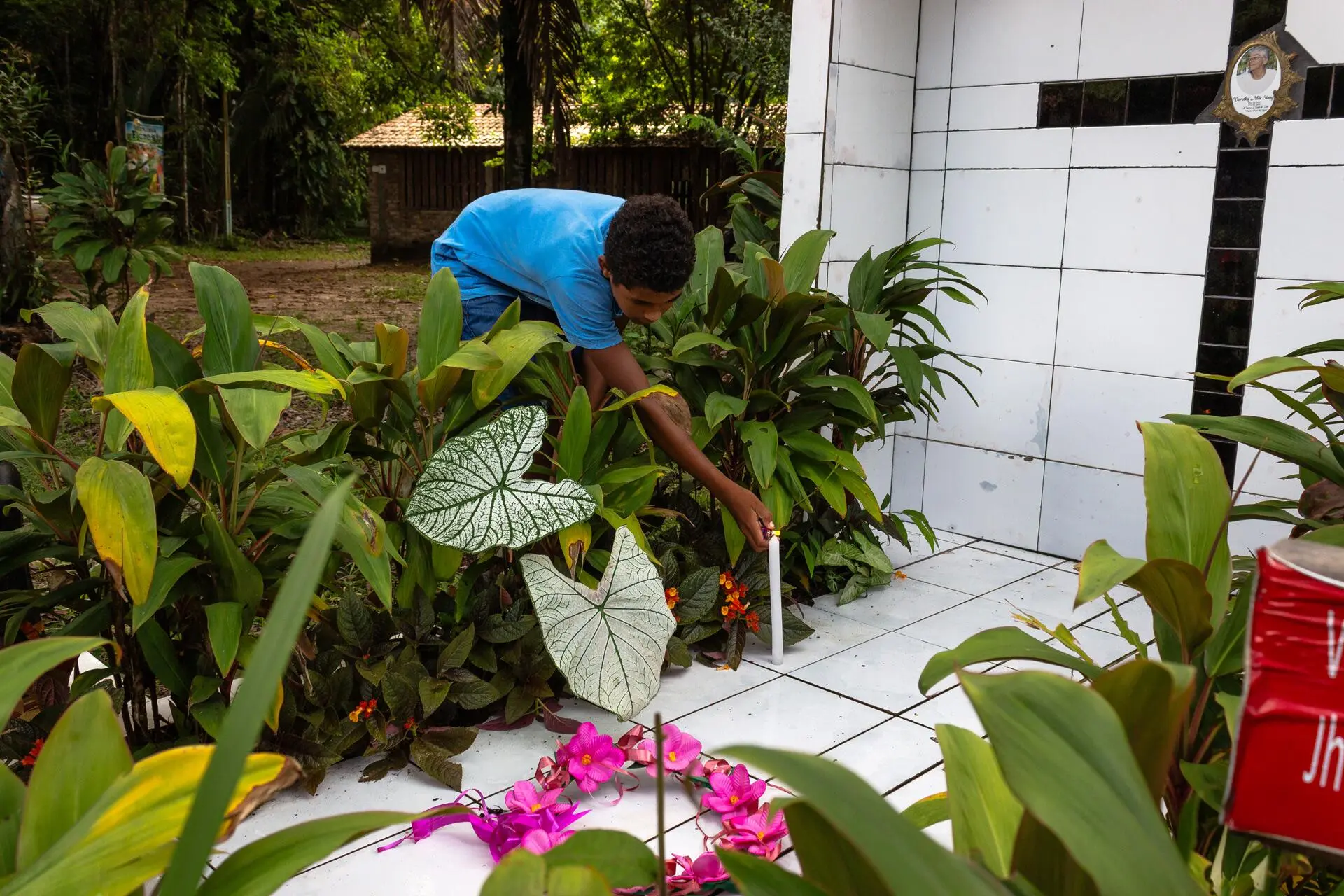
Legado: morador acende uma vela no túmulo da missionária Dorothy Stang, assassinada com seis tiros em 2005, a mando de grileiros
Em 1º de julho de 2022, ainda no governo do extremista de direita Jair Bolsonaro (PL), a Superintendência Regional do Instituto Nacional de Colonização e Reforma Agrária (Incra) no oeste do Pará criou o Projeto de Assentamento Dorothy Stang. A decisão só saiu por determinação da Justiça, provocada pelo Ministério Público Federal. A portaria do Incra estabelecia a criação de 73 unidades agrícolas familiares, exatamente o número de famílias do assentamento. Cinco dias depois, no entanto, a Diretoria de Desenvolvimento e Consolidação de Projetos de Assentamento, em Brasília, tornou sem efeito a portaria. A alegação oficial apresentada, à época, foi burocrática: a necessidade de “qualificar melhor o procedimento administrativo”.
Na verdade, o que ocorreu foi a paralisação política da reforma agrária no governo de extrema direita, “com queda drástica de orçamento e redução significativa de servidores”, como reconheceu a direção atual do Incra, em nota enviada a SUMAÚMA. “A partir do início de 2023, foram adotadas ações no sentido de reorganizar todo o funcionamento do órgão”, argumentam.
Um ano e sete meses depois, em 28 de fevereiro de 2024, foi publicada nova portaria, no Diário Oficial da União, assinada pela presidência do Incra, favorável à criação do assentamento. Finalmente o atual governo reconheceu o interesse social na área do Assentamento Dorothy Stang e regularizou a situação fundiária para reforma agrária. “As famílias assentadas no local estão aptas a acessar tanto políticas federais, como estaduais e municipais”, informou a assessoria do Incra.
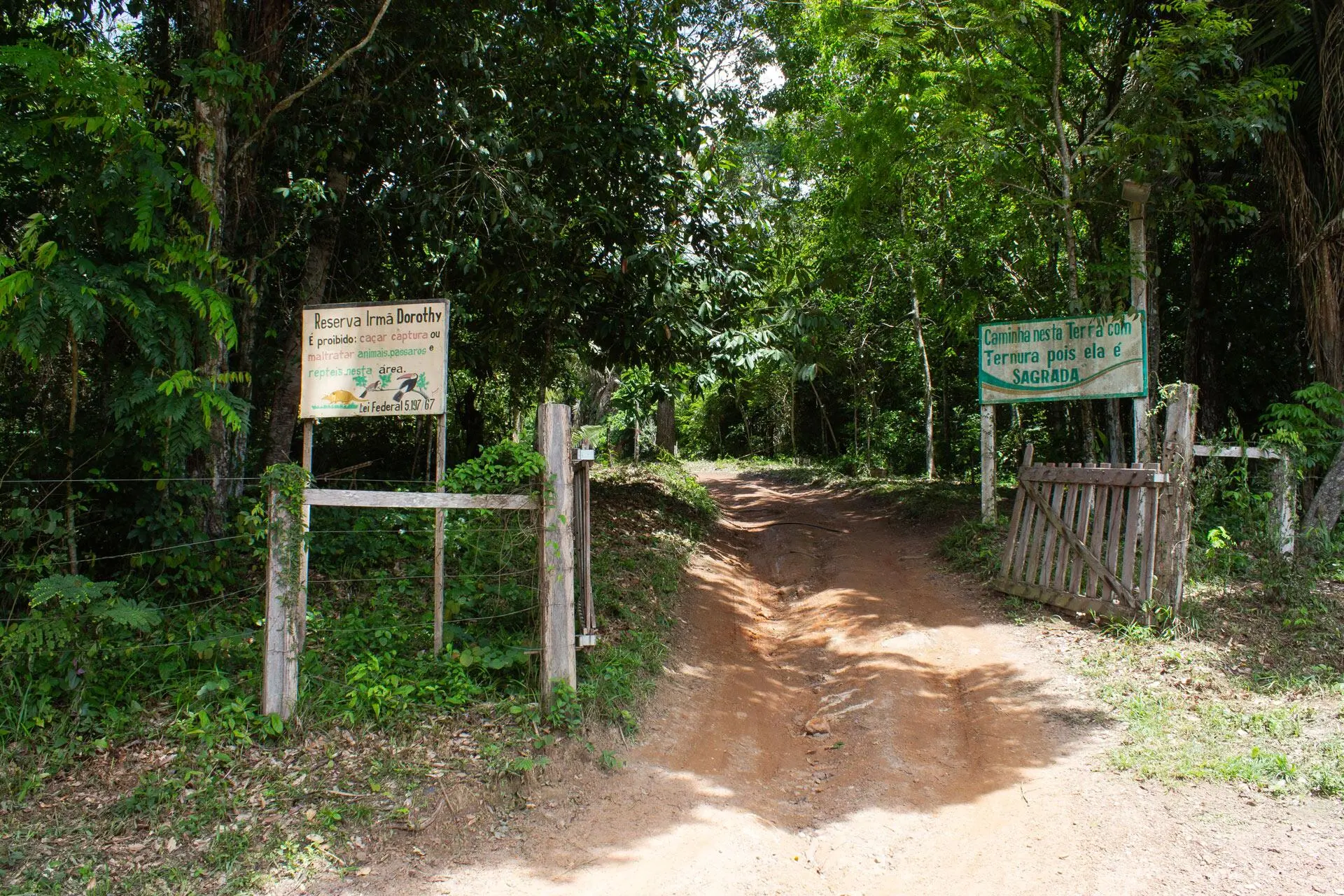
Conquista: Quase 20 anos depois da morte de Dorothy Stang, o assentamento foi reconhecido; memorial homenageia a irmã
O caminho para ter acesso a políticas públicas, no entanto, é penoso.
Em junho de 2023, a Equatorial Pará recebeu do Incra a lista de moradores do assentamento que estão regularizados e, portanto, passíveis de ligação elétrica em suas casas. Com os dados em mãos, o projeto para instalar energia no Dorothy Stang teve licenciamento ambiental deferido apenas em janeiro de 2024. “A obra está em trâmite de execução e possui previsão de atendimento até julho de 2024”, informou a empresa por meio de nota enviada a SUMAÚMA. Desde 2020 os moradores esperam pelo Programa Luz para Todos, criado no primeiro governo Lula, em 2003, para atendimento de famílias em áreas rurais. Até o início de maio, apenas 17 famílias tinham conseguido o acesso à energia.
Mesmo com o reconhecimento legal do assentamento pelo governo federal, para as pessoas que permanecem privadas de políticas públicas não há outra escolha a não ser lutar. Os “homens maus” responsáveis pela atrocidade de atear fogo à escola já repetiram o método com dezenas de famílias nos últimos dois anos. “A primeira vez que atearam fogo aqui foi na casa de uma senhora. Depois disso, ela foi embora, passou um ano fazendo tratamento para depressão, mas agora voltou ao território”, conta uma pessoa que pediu sigilo sobre a sua identidade. “Só registramos boletim de ocorrência dos dois incêndios da escola e de quatro casas de moradores, mas já perdemos as contas [de quantos ataques ocorreram].”
O Ministério Público Federal informou a SUMAÚMA que a investigação sobre o incêndio da escola tramita sob sigilo. A instituição solicitou a presença da Delegacia de Conflitos Agrários (Deca) no local assim que soube dos fatos, o que ocorreu dias depois. Quanto às constantes violações de direitos humanos no assentamento, o MPF afirma que tem acompanhado a situação para analisar se os direitos constitucionais dos moradores estão sendo desrespeitados.
Um espaço de luta que abriga flores
No local marcado pela impunidade, é fácil entender as razões pelas quais a pequena Ana Clara, de 6 anos, sonha em ser policial. A menina, de pele negra e cabelos encaracolados, diz que “quando for grande” quer prender bandidos que roubam e ateiam fogo à escola de crianças. “Quando eu for policial, eles vão passar meses presos”, garante.

‘Até onde for preciso’: Raimunda Silva, mãe da pequena Ana Clara, plantou flores no assentamento e promete lutar pelo direito da filha à educação
A família de Ana Clara vive em uma casa de madeira, de chão de cimento queimado, rodeada por flores que, na região, são chamadas de maria-sem-vergonha. Raimunda Soares da Silva, de 42 anos, mãe de criação de Ana Clara, conta que antes de chegar ao assentamento morava na Vila Gelado, no município de Novo Repartimento, também no Pará. De lá, além da família, trouxe várias mudas de flores, que hoje dão cor a um lugar repleto de cinzas. “Meu irmão morou aqui anos antes de mim e lembro de terem queimado a casa dele. Ele saiu um dia para pegar um açaí e na volta tudo estava incendiado.” A tragédia não impediu Raimunda de sonhar com o futuro da família no assentamento. Mas no momento o que a preocupa é o futuro de Ana Clara – e ela diz que vai “até onde for preciso” para garantir a educação da menina.
A Escola Paulo Anacleto, como tudo no assentamento, foi conquistada com muita luta. Lá estudavam 13 alunos de 4 a 12 anos, da educação infantil até o 6º ano do ensino fundamental. Até dezembro de 2019, porém, a maior parte das crianças da comunidade não estudava, porque a escola mais perto fica a 15 quilômetros – um trajeto de terra batida com lama e buracos, intrafegável em muitos trechos. No dia 27 daquele mês, o morador Paulo Anacleto finalizou a primeira reunião oficial para tratar da criação da escola. Ele fez o levantamento das famílias que tinham crianças e, com esses dados, formulou um documento, levado ao Ministério Público do Estado do Pará, em Anapu, pedindo à prefeitura a criação de uma instituição de ensino.

Antes do fogo: dia de aula normal no assentamento, em 2022. Foto: Mídia Ninja
Quem lembra da história é Erasmo Theofilo, liderança aguerrida do Lote 96. “Esse foi o início do processo de criação da escola. Na sequência, ele foi assassinado”, conta. Paulo Anacleto foi morto naquele dezembro de 2019, data do início do processo de exílio de Erasmo, sua companheira, Natalha, e seus cinco filhos. Ameaçados, eles tiveram que deixar o assentamento. O nome da escola foi uma forma de homenagear o companheiro que tombou. A morte de Paulo ocorreu cinco dias depois que outro líder da comunidade, Márcio Rodrigues dos Reis, foi assassinado com uma facada na garganta para mostrar que “falava demais”.
Em 7 de dezembro de 2020, Erasmo foi colocado no Programa de Proteção aos Defensores de Direitos Humanos, Comunicadores e Ambientalistas (PPDDH). Hoje ele e a família vivem num exílio forçado, mas seguem na luta, pedindo ao Estado por mudanças que possam de fato proteger e assegurar uma vida íntegra a defensores. O Ministério dos Direitos Humanos e da Cidadania não respondeu a SUMAÚMA sobre a revisão do programa e as violações de direitos em Anapu.
‘Se aparecer alguém, vocês correm’
O estado de alerta no Assentamento Dorothy Stang é constante, e não é algo restrito aos adultos. João Paulo, de 5 anos, é um menino risonho e falante. Ele é uma das crianças que vão para a escola a pé, na companhia do irmão mais velho, Pedro, de 9 anos. Todos os dias os dois disputam corridas pelo caminho. A brincadeira ajuda a executar com êxito o que aprenderam na escola: “A professora disse que, se algo acontecer, é pra gente correr. Coitado do João Paulo, porque ele corre muito devagar”, lamenta o mais velho.

Numa folha qualquer: nos desenhos das crianças do assentamento, a Escola Paulo Anacleto continua a existir, com sol, arco-íris, Pássaros, chuva e até Girafa
A mãe dos meninos, a lavradora Adenise Alencar, de 46 anos, conversa sempre com eles sobre os perigos que podem surgir no caminho. Além do clássico “não falem com estranhos”, ela alerta as crianças de que não devem brincar com o gado. O avanço da pecuária na região se tornou um perigo para os pequenos. Com a presença de bois nos arredores da escola, os pais, preocupados, construíram um banheiro de madeira para as crianças não se arriscarem no mato.
A resistência e a coragem das crianças do assentamento, que mesmo diante das cinzas ainda enxergam um futuro, também são fruto da dedicação e do esforço da professora. Por razões de segurança, a comunidade protege a identidade da educadora, que está bastante abalada e evita entrevistas após o mais recente incêndio criminoso.
Hoje, a Escola Paulo Anacleto existe apenas na memória e nos desenhos das crianças. SUMAÚMA pediu aos alunos que representassem, no papel, seus sentimentos. No traçado de Maria Júlia, a escola segue intacta, e o teto está cercado por um arco-íris. Ana Clara fez questão de colocar passarinhos azuis no espaço que, na vida real, foi queimado. No desenho de João Paulo, a sala de aula ainda é um esboço, como se o menino não se lembrasse mais do que havia ali antes do fogo. A Escola Municipal de Ensino Fundamental Paulo Anacleto vive no imaginário de todas essas crianças que, mesmo diante do horror, ainda teimam em sonhar.
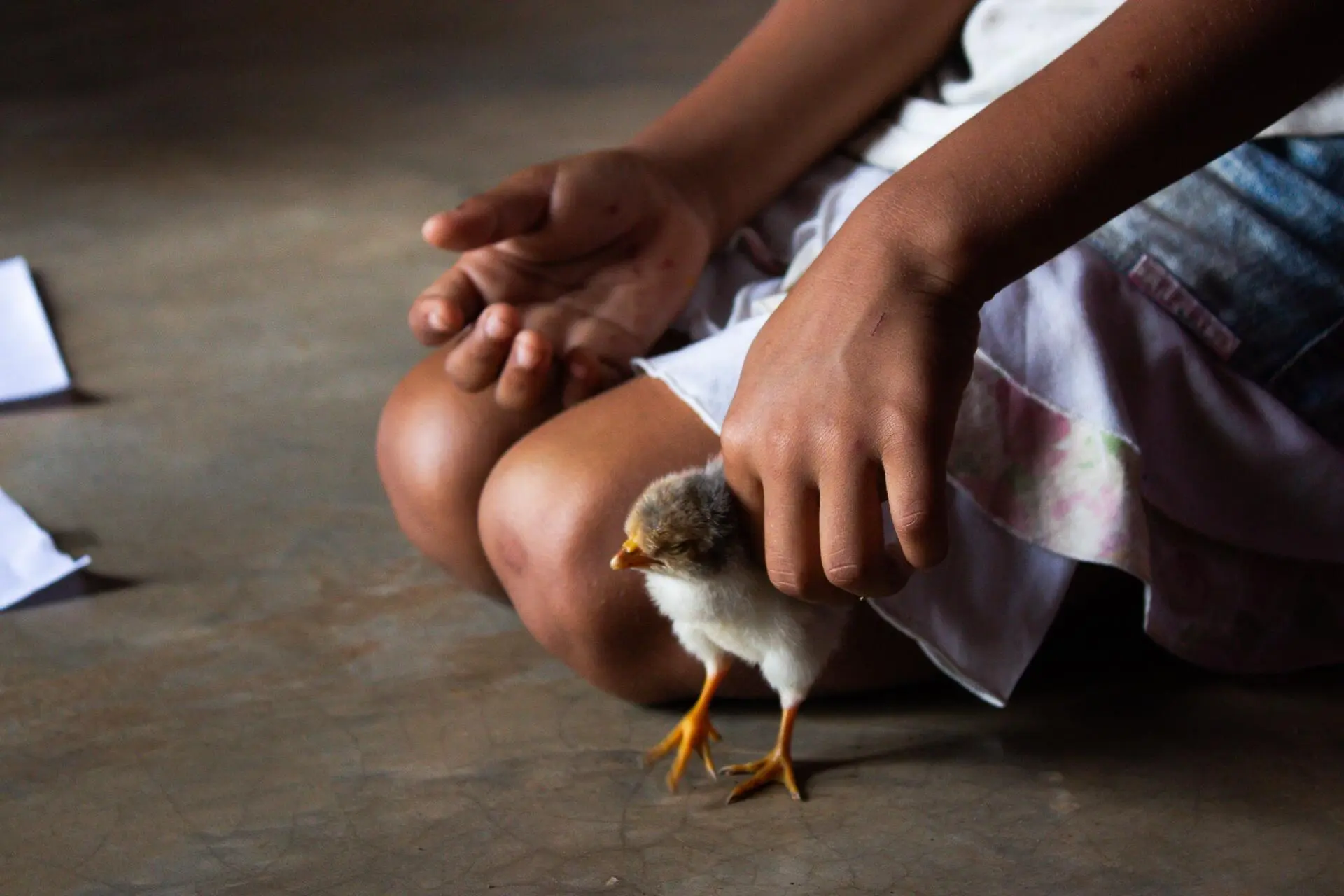
O que ninguém vê: a resiliência das crianças é o que traz a certeza de futuro no assentamento, ainda que direitos sejam constantemente violados
Reportagem e texto: Catarina Barbosa
Edição: Malu Delgado e Eliane Brum
Edição de fotografia: Lela Beltrão
Checagem: Plínio Lopes
Revisão ortográfica (português): Valquíria Della Pozza
Tradução para o espanhol: Julieta Sueldo Boedo
Tradução para o inglês: Sarah J. Johnson
Montagem de página e acabamento: Natália Chagas
Coordenação de fluxo editorial: Viviane Zandonadi
Chefa de reportagem: Malu Delgado
Editora-chefa: Talita Bedinelli
Diretora de Redação: Eliane Brum





